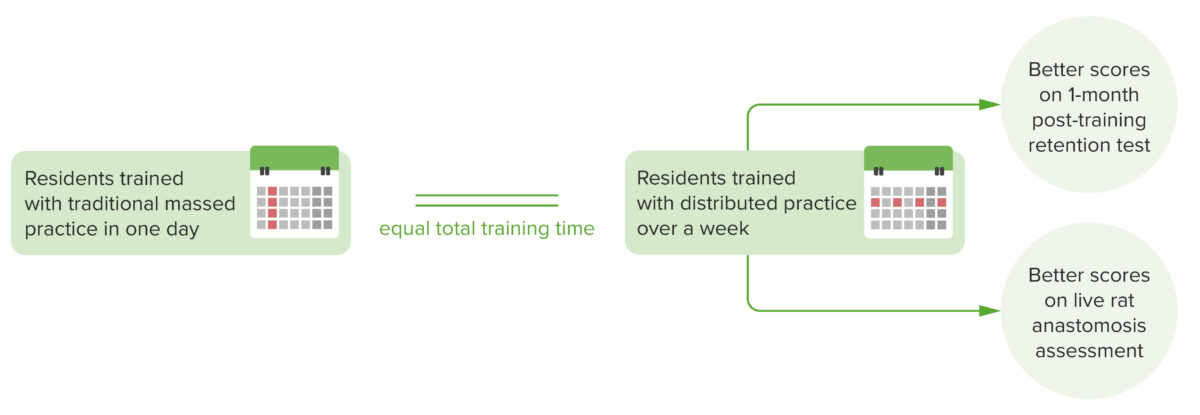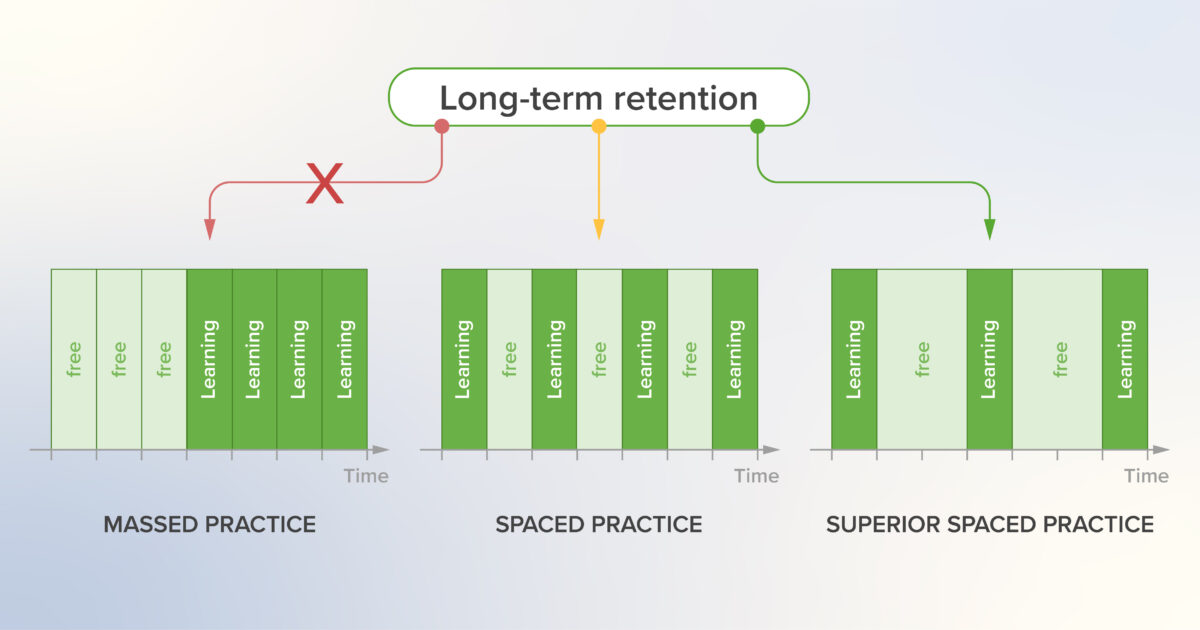Introduction
Although the challenges of 21st-century medical education are daunting, research on the cognitive, educational, and neuroscientific fronts has converged on several effective strategies for teaching and learning. One of these educational tools is spaced learning. “The spacing effect is one of the oldest and best-documented phenomena in the history of learning and memory research,” according to researchers Bahrick and Hall.(1) Over 100 years ago, Ebbinghaus suggested that the ability to remember something depends on the number of times it is reviewed, the distribution of these reviews over time, and the time elapsed since the last review.(2) If this strategy is novel to the reader, it may be due to confusion about the term “spacing” itself. The spacing effect is referred to in the literature in a number of different but interchangeable terms, including “spaced learning,” “distributed practice,” “spaced education,” “spaced practice,” “distributed learning,” “spacing effect,” and “spaced rehearsal” to name just a few. In fact, one research group investigated recent evidence in the scientific literature and found 20 associated terms with 74 different definitions of spaced learning in just the past 10 years of publications.(3) Despite variability in the term used for this learning practice, there is wide consensus that spacing is very effective and should be implemented extensively by educators and learners. Moreover, distributed practice has been shown to increase learner success on various criterion-based assessments, across multiple educational disciplines, and over a wide age spectrum of learners.(4)
What Is Spaced Practice?
Spaced practice is a learning technique that can improve knowledge attainment by spreading out study time over a longer period with interspersed breaks. It is essentially the opposite of cramming. For example, the University of California San Diego psychology program suggests that students should study 1–2 hours every other day for a week instead of a 12-hour cramming session in one sitting.(5) Versteeg et al. defined spaced learning as follows: “Spaced learning involves (specified) educational encounters that are devoted to the same (specified) material, and distributed over a (specified) number of periods separated by a (specified) interstudy interval, with a (specified) learning outcome after a (specified) retention interval.” (3) Scientists have yet to clearly define the time periods for interstudy space, but it should be long enough for some forgetting (and therefore difficulty) to occur. An interval between study sessions also allows for neural consolidation, which is important for augmenting long-term memory.
Robert and Elizabeth Bjork introduced the term “desirable difficulties” to mean that certain strategies which seem more challenging in educational practice can nonetheless lead to enhanced learning. Students can easily be misled as to whether they are learning effectively and often confuse familiarity with a subject with mastery. Unless there is a level of mental effort exerted when studying, then the establishment of knowledge in long-term memory cannot be achieved. (6)
There are several approaches to learning that fall into the category of “desirable difficulties” and spaced learning is one of them. Spaced learning (closely related to but not synonymous with spaced retrieval) is one of the techniques that may assist with both declarative and procedural learning.(7) When a learner is first introduced to unfamiliar material, the brain struggles to establish appropriate neural connections. One way to improve neural connections is to take a break from studying the information but return to it again and again. This revisiting is thought to help develop preferential neural patterns in both the procedural and declarative pathways and to help to form permanent links in long-term memory.(7) This pattern allows for some forgetting in between study sessions, and this has been shown to improve long-term retention. However, as a result of forgetting, learners are forced to engage in a more effortful but productive retrieval process. Spaced learning and spaced retrieval are complementary elements of durable learning. Spaced practice with a more prolonged interstudy (free) time is best for long-term understanding.
Spaced learning effect: Spaced practice with enough interstudy time for forgetting is best for long-term retention.(3)

Another effective learning technique that falls under the “desirable difficulties” category is interleaving. In interleaving, the different but related material being studied is intentionally interspersed within the study periods. There is evidence indicating that spaced practice combined with interleaving may be critical for enhancing learning beyond what can be achieved with spacing alone.(8)
Essentially, interleaving pertains to what happens in between spacing, specifically the study of similar but distinct content. Interleaving therefore necessarily involves spaced practice, as can be seen in the example below on the right, where concepts A, B, C, and D are both spaced out and interleaved. But spacing can be practiced without interleaving, as shown by the example in the middle, where studying of the concept A is spread over time, whereas concepts B, C, and D are blocked without mixing them up.(9)
Interleaving always involves spaced practice (example on the right), while spaced practice can be practiced without interleaving (example in the middle)

Evidence for Spaced Learning
There is a wide body of research that demonstrates the benefits of applying spacing to educational practices.(10–12) Spacing out studying enables better long-term retention of knowledge. In a recent meta-analysis, researchers reviewed 839 assessments of spacing in 184 research articles and found that, when learners increased the time between study periods of the same material, their retention level of the material also increased.(13) Learners themselves may be convinced that lots of practice in a short period of concentrated time improves assessment performance, but these gains are only superficial and short-lived if the study time is not distributed. Cramming, or massed practice, can heighten “momentary strength,” but it takes the desirable difficulties of spaced practice to achieve “underlying habit strength” that results in durable learning.(14)
How much interstudy time is necessary in a spaced learning program? The answer is not yet clearly specified from the research, but it is suggested that learners need enough time so that studying is not a “mindless repetition” and some forgetting occurs. Students can utilize spacing when working with something as familiar as using flashcards, increasing the time interval between study sessions with flashcard topics, and rotating the cards that are successfully answered with ones that are yet to be mastered, to reap the learning benefits of spaced practice. Increasing the time intervals between practices increases mastery of the material too.(14)
Alternatively, spaced study can be very effectively guided by computer-based algorithms. One recent study looked at the effects of spacing algorithms on learning a new language using an online platform. The results showed that students who used the spaced learning schedule determined by the algorithm memorized more effectively than those who did not follow the prescribed schedule.(15) Another study examined the effect of distributed learning on grade school students’ ability to learn science concepts. The researchers found that, in a comparison between science lessons that were massed, clumped (or semi-spaced), and spaced, the students demonstrated superior application of knowledge with the spaced lessons.(12)
Is cramming ever successful? The research says yes, but within very limited parameters—massing is better than spacing only on immediate tests, but spacing is better than massing on long-term assessments.(16) More specifically, if learning time is a constraint and massed practice is necessary, then at least the learner should try to vary encoding (using different terms/phrases related to the material or different diagrams/pictures) when studying.(16) Above all, learners should recognize that avoiding mass practice will result in less overall effort in the long run. While massed practice can be very successful for gaining a good mark on an imminent examination, the knowledge acquired will be short-lived. To ensure long-term mastery of the material, learners should adopt a spaced learning study program.
Spaced learning in the context of medical education has not yet been extensively studied. One medical school evaluated spaced practice by periodically emailing their third-year medical students a case scenario or a short clinically based question on urology topics. Students were randomly chosen to receive these emailed assignments in only 2 of the 4 required urology topics.(17) The final assessments showed that the spaced learning email assignments had positively impacted the students’ scores, even though spaced retrieval effects may have also been involved in the achievement of better grades.(17)
There is evidence that spaced learning is successful in complex motor skill acquisition in medicine. In a pilot study that looked at spaced learning for laparoscopic suturing techniques, the researchers found that the group that received spaced learning instruction was superior to the traditionally trained students in all categories of the surgical assessment.(18) In addition, the investigators found that the spaced learning group of students had less anxiety and a greater sense of confidence in their skills than did the group that used traditional massed practice.
Spacing effect successful with surgical resident training (microvascular anastomosis)(19)

In another medical classroom study, junior surgical residents were taught a new surgical skill (microvascular anastomosis) and randomly assigned to either a one-day massed practice group or a distributed practice weekly regime involving the same total amount of time (see figure above).(19) The residents’ performance was statistically better when taught in a distributed manner, measured by both a 1-month retention test and a live rat anastomosis assessment. The authors concluded that, even though there were logistical challenges involved in teaching this way, the outcomes warranted restructuring the training for both CME and residency curricula.
Why Spacing Works
Insights from cognitive science
There are several theories of why spaced practice works, but a recent meta-analysis has suggested that the following two major theories may best describe the cognitive science behind spacing:(16)
Encoding variability: This theory hypothesizes that an item is more likely to be encoded in the brain in different ways when practice is spread out rather than massed together.(20) The assumption is that the increase in encoding variability leads to an increase in retrieval routes in the brain. It is thought that having multiple neural pathways increases the probability of success when retrieval of knowledge is required.
Study-phase retrieval: This theory proposes a major role for recurring “reminding” that results from spaced practice. This repeated reminding may be consciously recognized and can be used as a way of increasing recollections for later retrieval.(21) Wahlheim et al. hypothesize that the use of successful reminding might create elaboration of the memory traces in a way that is similar to the proposed mechanism of encoding variability.(22) The researchers noted that the second presentation of the material seems to be critical in increased retrieval, but more research needs to be done to understand how these practices adjust the way information is stored in long-term memory.
Maddox concluded that it is likely that a combination of the encoding variability theory and the study-phase retrieval theory may be the best explanation of why the spacing effect is successful.(16) Interestingly, there is also evidence that learners’ minds are more focused with spaced practice compared with mass practice. The authors hypothesized that this is due to attentional factors being stronger during spaced practice.(23)
Insights from neuroscience
The power behind the benefits of spaced learning is thought to lie in the neural process called consolidation. A simple visualization of the consolidation process can be seen in the figure below. When a student is first introduced to a subject, the neural connections are more disordered and weak. Over time and with distributed practice, the hippocampus influences the strengthening of some synaptic connections while other neural patterns are pruned away. Finally, only the most efficiently arranged neural connections remain in long-term memory and can be accessed by working memory upon demand.(7) It is assumed that this process is a result of synaptic and neuronal modifications in which the initially encoded memory undergoes a process of repeated reactivation during sleep as well as consciousness.(24)
Neural process of consolidation(7)

Sleep is critically important to spacing via the vehicle of consolidation, but does the learner actually have to lose consciousness for it to occur? A 2019 study compared sleep, quiet wakefulness, and active wakefulness (watching videos or going about typical daily activities) during the lag time of spaced learning. The results revealed that sleep was not required to achieve improvement on a memory test and that a state of quiet wakefulness also showed similar benefits to sleep.(25)
Practical Applications for Spaced Learning in Medical Education
Implementation in the classroom
Instructors need to be aware that, although spacing is a very powerful learning strategy, it is important to tell students that it will take the same amount of study time, but will feel more difficult. An example of implementing spaced learning into the classroom could be assigning a concept map that pulls in related material covered days or weeks before and asking students to integrate those concepts into current topics.(9) Spacing can be applied to any subject matter and works particularly well for procedural learning.(26) Teachers could encourage the use of the Leitner system of flashcards, which incorporates practicing flashcard concepts in categories of “successfully answered cards” and “yet-to-be-mastered cards” that are reviewed in recurrent and increasing periods of time.(27) It is advantageous for instructors to spread out course topics over a longer period in order to integrate scheduled review times. It works well to incorporate the practice of interleaving using related and already familiar material in combination with spaced study.
E-learning implementation
There is vast potential inherent in the use of technology to successfully implement spaced learning. Some electronic resources from textbooks or other curricular materials provide spacing practice options. Designers of content can effectively create rest time in between periods of active learning to maximize the benefits of spacing.(28) Adaptive e-learning tools and data-driven algorithms can customize educational enhancements for learners, including spaced learning and strategies such as spaced retrieval and interleaving.(29) Pumilia et al. noted that, even though learning methods like spacing gave learners the perception of lower competency, the use of these techniques was actually associated with improving long-term retention of material.(30) This is another reminder that teachers need to educate their students about the evidence behind the use of these challenging educational tools and that their reward is more sustainable learning.
Recommendations
Educator’s perspective
Educators should teach students about the research behind effortful studying practices like spacing and that the benefit of using them is better knowledge retention in the long run. Instructors should schedule material to be covered over the course of multiple weeks with the goal of infusing spacing into their teaching. By planning a curriculum with distributed learning in mind, educators can ensure that this powerful tool is utilized in their courses. The course design should drive students to use this practice by finding ways to return to course content throughout the term and not just on a cumulative examination at the end.
Student’s perspective
When working with online learning, the student must be aware of the possibility of procrastination. It is important for online learners to schedule a time to implement spacing practices when learning new material. Students should create a timetable for studying for examinations at the beginning of the course and stick to it to allow for spacing practices. This is especially true for medical learners, as durable learning helps them to become skillful health care providers in the future. Finally, students should be encouraged to evaluate their own studying practices and base precious time investments on scientifically proven methods to foster learning.
Conclusion
Spaced practice is superior to massed practice because the desirable difficulties it produces in learners are rewarded by improved long-term retention of material. This is crucial not only in order to have information readily at hand when taking summative board examinations but also when making important decisions in treating patients. There is a wealth of evidence-based scientific research that supports this effective educational practice, both from cognitive science and neuroscience perspectives. Distribution of learning and/or spaced reviewing of medical concepts and of clinical training is advantageous in almost every circumstance to massed practice and results in durable learning. Technological applications such as platform-based delivery and tracking greatly facilitate the implementation of spaced learning.
Self-Quiz
(Please select all that apply)
1. In order to achieve optimal benefits from spaced practice, which of the following is the best option?
a. Utilize space study time with limited interstudy periods.
b. Utilize distributed practice and integrate other related subjects during interstudy time (interleaving).
c. Vary the time of day for study periods.
d. Alternate visual resources with auditory resources for better encoding.
2. Consolidation can occur under the following conditions:
a. Sleep only
b. Rest only
c. Effortful study
d. Sleep and rest
3. What are some examples of ways that spaced practice can be incorporated into the classroom?
a. Programming rest times into electronic assignments in order to facilitate consolidation
b. Asking students to discuss lecture questions immediately upon the completion of the lesson
c. Using the Leitner system of flashcard study
d. All of the above
4. What are some ways that educators can motivate students to utilize spaced practice since they will undoubtedly encounter desirable difficulties?
Correct answers: (1) b. (2) d. (3) a, c. (4) free response
Online Seminar
This online seminar from Lecturio’s Durable Learning series explores the concepts of Spacing and Interleaving and how they can provide better long-term learning outcomes. We also share practical recommendations on the integration of Spacing and Interleaving into medical education, both in physical and digital classrooms.
Watch the seminar recording:
Would you like to learn more? Explore the Pulse Seminar Library.



